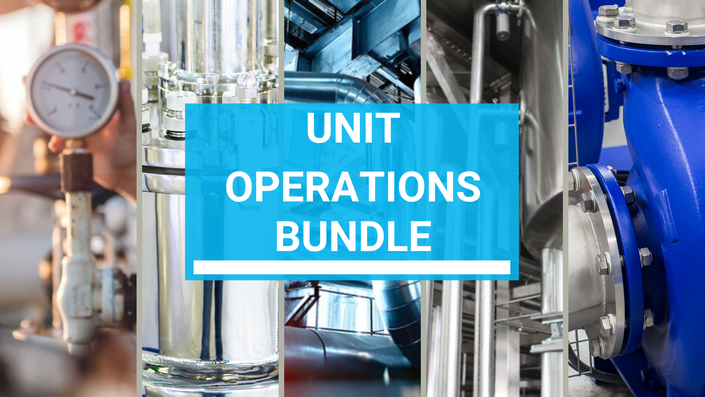Course Trailer
About this Course
📚 This Gas Absorption & Stripping in Chemical Engineering course focuses on the essential principles and techniques used to design and analyze gas absorption and stripping processes. These processes are vital for efficient gas-liquid interactions in industries such as chemical manufacturing, environmental control, and energy production.
Key topics covered include:
- Fundamentals of Gas-Liquid Contacting
- Absorption Columns (Packed and Tray)
- Stripping Processes and Columns
- Mass Transfer in Absorption and Stripping
- Design Equations and Performance Evaluation
- Energy Integration and Optimization
👨🏫 Designed for
Chemical engineering students, process engineers, and professionals working in industries where gas absorption and stripping are critical, such as petrochemical, environmental engineering, and air pollution control.
📚 Course Approach
A theoretical and practical approach with detailed explanations of key concepts, along with hands-on examples and process simulations.
🎯 By the end of the course, you will be able to:
- Understand the principles of gas absorption and stripping
- Design and analyze absorption and stripping columns
- Calculate key parameters like mass transfer coefficients and column efficiencies
- Apply design equations to real-world gas absorption and stripping processes
- Optimize and troubleshoot gas-liquid separation systems for improved performance
🚀 Recommended for
Students and engineers looking to specialize in gas separation processes or improve their expertise in the design and operation of gas absorption and stripping systems.
✅ You’ll learn to:
- Set up and design absorption and stripping columns
- Apply mass transfer theories to optimize separation processes
- Use process simulation tools to model gas absorption and stripping
- Evaluate and improve the efficiency of gas-liquid interactions
- Solve real-world engineering problems in gas absorption and stripping

Self-Paced, Dynamic Lectures
Learn at your own pace, anytime and anywhere.
The lectures are concise, engaging, and focused—designed to maximize your understanding efficiently.

Example Title
Use this block to showcase testimonials, features, categories, or more. Each column has its own individual text field. You can also leave the text blank to have it display nothing and just showcase an image.

Evaluations, Quizzes
Evaluate your progress through interactive quizzes and self-assessments.
Reinforce key concepts, identify gaps, and ensure you're ready to apply what you've learned in real scenarios.

30 Day Money-Back Warranty
Enroll with confidence—if the course doesn’t meet your expectations, you can request a full refund within 30 days.
No questions asked.

Certificate of Completion
Receive an official certificate or diploma once you finish the course—perfect for showcasing your new skills on your resume, LinkedIn, or job applications.

Instructor Support
Get guidance whenever you need it—ask questions, request feedback, and interact directly with the instructor throughout the course.
Curriculum
- Mass Transfer Review - An Introduction (2:26)
- 2.1 Equilibrium (0:29)
- What is Equilibrium? (3:36)
- Vapor Pressure (4:55)
- Partial Pressure (2:38)
- Raoult’s Law (5:17)
- Gas Solubility in Liquids - Overview (5:25)
- Gas Solubility Analysis (2:49)
- Henry’s Law (6:48)
- 2.2 Diffusion & Convection (0:45)
- What is Flux? (9:05)
- What is Ja? Diffusion Flux (2:42)
- What is Molecular Diffusion? (6:48)
- Fick's Law (4:56)
- Engineering Applications for Diffusion (3:21)
- Case A - Equimolar Counter-Difussion (EMD) (6:45)
- Exercise#01 - EMD (14:04)
- Case B - Unimolecular Diffusion (UMD) (16:27)
- Exercise#02 - UMD (6:31)
- Convection in Mass Transfer (4:38)
- 2.3 Interphase Mass Transfer (1:12)
- Equilibrium Distribution Curve (6:08)
- Film Concept (5:05)
- Two-Film Theory (6:08)
- Two-Film Theory and Equilibrium Solubility Curve (8:53)
- Analysis of Mass Transfer Process using Two-Film Theory (5:46)
- Film MT Coefficients (7:50)
- Local MTC: kx, ky (3:27)
- Mass Transfer Coefficients & Correlations (3:31)
- Overall Mass Transfer Coefficients (6:29)
- Local vs. Overall (MTC) (3:23)
- Mass Transfer Resistance (2:35)
- Analysis of Gas Solubility (4:44)
- Closure of Mass Transfer Review (0:56)
- Introduction to Gas Absorption (1:13)
- What is Absorption? (8:32)
- Nomenclature in Absorption (2:58)
- Gas Absorption Examples (9:25)
- Physical vs. Chemical Absorption (2:34)
- Scope of the Course (3:53)
- Desorption & Stripping (3:08)
- Stripping Examples (3:38)
- Case Study - Amine Gas Treating AKA Sweetening Sour Gas (9:20)
- Equipment & Operation (Absorption and Stripping) (4:10)
- Type of Equipment - Dispersion of Gas-Liquid and Liquid-Gas (4:12)
- Spray Column (2:36)
- Bubble Column (2:00)
- Packed Column Intro (1:32)
- Tray Column Intro (1:25)
- Steps for Absorption Column Design (6:27)
- Solvent Selection (1:40)
- Solvent Selection - Gas Solubility (2:28)
- Solvent Selection - Volatility (0:58)
- Solvent Selection - Corrosiveness (0:45)
- Solvent Selection - Cost (1:09)
- Solvent Selection - Viscosity (1:19)
- Solvent Selection - Safety (1:00)
- Types of Operations (1:39)
- Single vs. Multiple Stages (8:28)
- Gas Absorption Closure (0:46)
- Introduction to Tray Absorbers (4:22)
- 4.1 Introduction to Tray Columns (0:58)
- Introduction to Tray Columns (4:18)
- 4.2 Equipment used in Tray Columns (1:22)
- Sieve Trays (4:08)
- Valve Trays (3:57)
- Bubble Cap Trays (3:39)
- Tray Considerations (0:27)
- Trays - Spacing (2:28)
- Trays - Sizing (1:12)
- Trays - Layouts (4:48)
- Trays - Materials (2:50)
- Trays - Manways (1:30)
- Trays - Operations (1:37)
- Tray - Pressure Drop (1:27)
- Trays - Costs (1:07)
- Tray - Maintenance (0:53)
- Trays - Summary (1:04)
- All other Pieces (0:27)
- Bubbling Area (1:43)
- Contact Area (1:24)
- Weir (2:34)
- Downcomer (3:54)
- 4.3 Design & Model (0:23)
- Counter-current Operation (5:47)
- Counter-current Operation for Dilute Systems (5:47)
- The Operation Line (4:40)
- Exercise#03 - Operation Line (5:54)
- The Equilibrium Line (4:09)
- Plotting both Lines (6:11)
- Min. Solvent Flow Rate (L/G) (12:23)
- Exercise#04 - Min. Liquid Flow Rate Calculation (5:51)
- Exercise#05: Analytical Calculation of Lmin (13:33)
- Other Cases for Absorption in Co-Current, Counter-current, Stripping, etc... (1:22)
- Co-Current Operation (1:53)
- Counter-Current Gas Stripping (1:39)
- 4.4 Number of Equilibrium Stages (1:18)
- Nomenclature used in Gas Absorption (6:30)
- Graphical Method - McCabe Thiele (5:33)
- Exercise#06 - Graphical Method (13:48)
- The Dilute Absorption Factor "A" (1:25)
- Analytical Method - Kremser Equation (3:16)
- Exercise#07 - Kremser Equation (4:46)
- Exercise#08: Kremser vs. Graphical (3:58)
- Dynamic Simulation - Absorption Column (7:26)
- Dynamic Simulation - Stripping Column (4:09)
- Exercise#09 - Absorption (mass fraction) (9:56)
- Stage Efficiency (5:44)
- Murphree's Efficiency (3:30)
- Examples of real industrial process stage efficiencies (1:44)
- Exercise#10: Stage & Murphree Efficiencies (2:53)
- Exercise#11: Gas Absorber & Murphree Efficiencies (11:50)
- Column Operation (2:51)
- Column Operation - Normal (2:04)
- Column Operation - Flooding (3:41)
- Column Operation - Priming (2:26)
- Column Operation - Coning (1:43)
- Column Operation - Weeping (1:47)
- Column Operation - Dumping (3:37)
- Column Operation - Summary (3:34)
- Tray Diameter Introduction (6:14)
- Tray Spacing Height (2:25)
- Exercise#12: Diameter of a Tray Column (13:58)
- Pressure Drop in Trays (3:49)
- Hd, Dry Liquid sieve loss - Pressure Drop in trays (3:07)
- Hl, (equivalent h eight of clear liquid holdup) (3:39)
- Hd, Surface Tension Pressure loss (1:17)
- Exercise#13: Pressure Drop in a Tray Columns (11:25)
- Summary of Exercises 11, 12 and 13 (4:42)
- Closure of Trayed Absorbers
- Introduction to Packed Columns (2:06)
- 5.1 Intro to Packed Towers (1:51)
- Approach to Design (2:29)
- 5.2 Equipment in Packed Columns (0:20)
- Packed Columns vs. Tray Columns (5:03)
- Introduction to Packings (4:05)
- Packing Material (2:26)
- Random Packing (1:28)
- Stacked Packing (1:39)
- Structural Packing (0:58)
- Other Column Internals (1:51)
- Liquid distributor (2:13)
- Liquid/Vapour Re-Distributor (1:07)
- Vapour Distributor (1:12)
- Demister / Mist Eliminator (1:45)
- Vortex breaker (0:48)
- Packing Supports (1:23)
- Retaining devices (Hold-down Plate & Bed limiter ) (1:07)
- Column Structure - Top (1:23)
- Column Structure - Middle (1:44)
- Column Structure - Bottom (10:33)
- 5.3 Design & Model (2:32)
- Introduction to Column Diameters & Pressure Drop (3:51)
- Analysis of Drop in Pressure in Packed Towers (7:53)
- Flow Parameter vs. Pressure Drop Parameters - Graph (4:07)
- Flow Parameter vs. Pressure Drop Parameter - Equation (1:36)
- Flooding Pressure Drop Correlation (1:49)
- Method 1: Fractional Approach to Flooding Gas Velocity (Absorber Diameter) (4:35)
- Method 2: Maximum Pressure Drop Approach (Absorber Diameter) (7:35)
- Exercise#14 - Drop in Pressure due to Packings (12:55)
- Exercise#15: Pressure drop in a Packed Column (6:58)
- Exercise#16: Pressure Drop in an Ethanol Absorber (50mm Hiflow Metallic Rings) (11:48)
- HETP (Height Equivalent to a Theoretical Plate) (10:14)
- Exercise#17 - HETP (2:03)
- Exercise#18 - HETP (4:39)
- Method of Transfer Units (4:34)
- Number of Transfer Units (NTU) (1:25)
- Height of Transfer Unit (HTU) (2:11)
- Overall vs. Local Mass Transfer coefficients in MTU (3:00)
- Gas Phase - Method of Transfer Units - MTU (4:22)
- Liquid Phase - Method of Transfer UnitsMTU (2:13)
- Exercise#19 - Mass Transfer Units Method in a Packed Columns (6:14)
- Steps - Method of Transfer UnitsMTU (2:31)
- Method Comparison - HETP vs MTU (3:48)
- Exercise#20: Mass Transfer Units Design (6:45)
- Exercise#21 Packed Column Height increase due to increase in purity (4:40)
- Exercise#22 Packing Height: Acetone-Air-Water (6:14)
- Packed Columns Closure (2:32)
- Introduction to Advanced Systems of Absorption (2:39)
- Non-diluted Cases in Tray Columns (7:46)
- Exercise#23 Concentrated Tray Column Absorber (11:04)
- Packed Columns in Non-diluted Cases (1:35)
- Exercise#24 Concentrated Case - Packed Column (11:20)
- 6.2 Multicomponenet Absorption (5:20)
- Methodology for Multicomponent Absorption (6:16)
- Case Study - Multicomponent Absorption (15:22)
- Sum-Rates (SR) Method for Absorption and Stripping (9:38)
- 6.3 Reactive Absorption (4:06)
- Advanced System Closure (1:07)
- Introduction to Software Simulation of Absorption Systems (1:35)
- Aspen Plus - Introduction (2:18)
- Models of Absorption in Aspen Plus (3:53)
- Case Study 1 - Problem Statement (3:08)
- Case Study 1 - Simulation & Results (14:59)
- EXTRA - Case Study 1 - Tray Sizing Effects (3:04)
- EXTRA - Case Study 1 - Trays vs. Packings (4:18)
- EXTRA - Case Study 1 - Diluted vs. Concentrated Case (5:18)
- Aspen HYSYS - Introduction (1:46)
- Models of Absorption Columns in Aspen HYSYS (3:04)
- Case Study 2 - Problem Statement (7:54)
- Case Study 2 - Simulations & Results (2:39)
- EXTRA - Case Study 2 - Multicomponent Absorption (3:13)
- Closure of Absorption Simulation with Software (1:08)
Course Enrollment
This and all other courses are available only via the All Courses - One Subscription Membership.

Hi, I’m Emmanuel Ortega,
a.k.a. the Chemical Engineering Guy!
With five years in the chemical industry, from petrochemical plant design to polyester textiles, I bring real-world experience to show the true value of engineering knowledge.
My Expertise:
- Process Simulation & Optimization
- Chemical Process Design
- Process Equipment Design
- Automotive & Industrial Polyester Yarn Technologies
- Online Tutoring, Online Education Management
The Courses I design are entirely dynamic. You will see theory and then apply it ASAP to a real life problem! I even use the books you are using right now in your engineering courses...
I'll see you in class!
Frequently Asked Questions (FAQ)
- When does the course start and finish?
- The course starts now and never ends! It is a completely self-paced online course - you decide when you start and when you finish.
- How long do I have access to the course?
- *How does lifetime access sound? After enrolling, you have unlimited access to this course for as long as you like - across any and all devices you own.
- NOTE*: This is true as long as you keep your subscription active.
- What if I am unhappy with the course?
- We would never want you to be unhappy! If you are unsatisfied with your purchase, contact us in the first 30 days and we will give you a full refund.
- Will I Get a Certificate/Diploma of Completion?
- Yes! After the course, you will get a Certificate of Completion with a Diploma! You can use this in your Resume!
- Are Resources Downloadable?
- Absolutely YES! Every resource is available for download, allowing you to study alongside them.
- Any doubt? Message me!
- Please reach out! [email protected]




